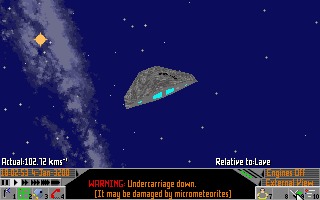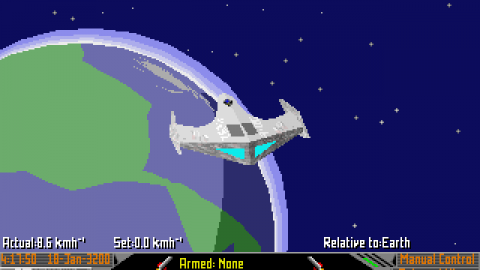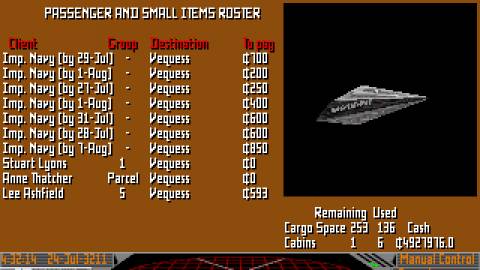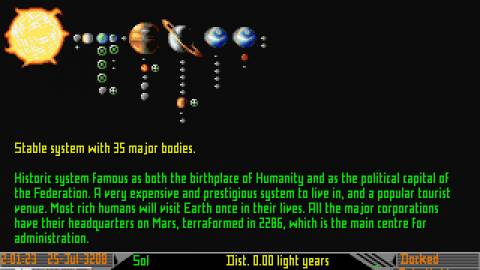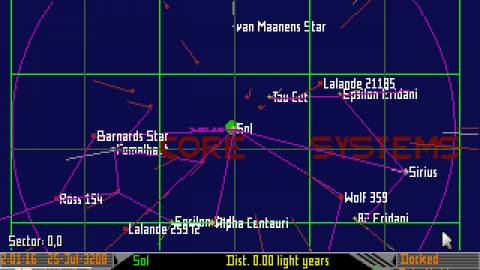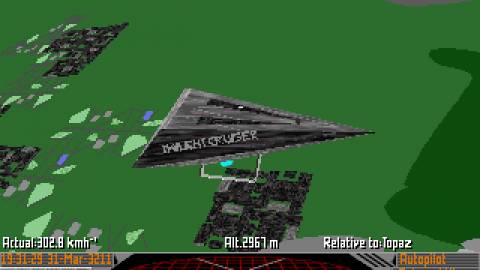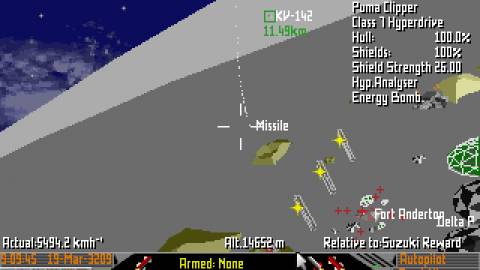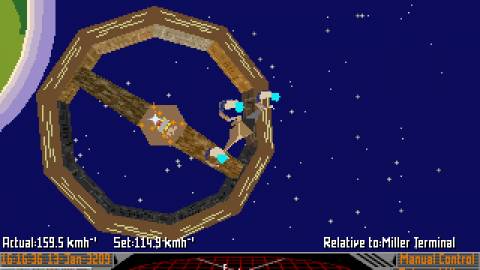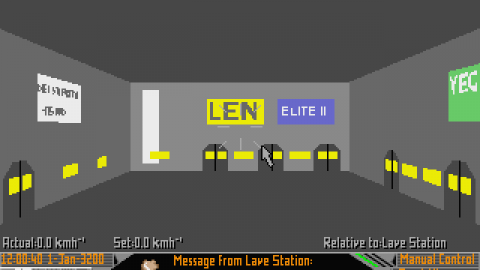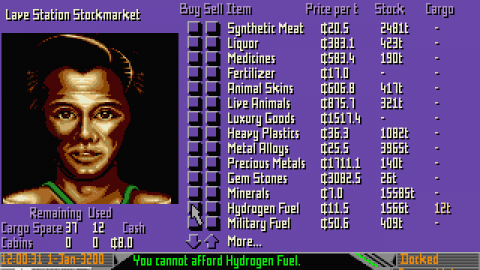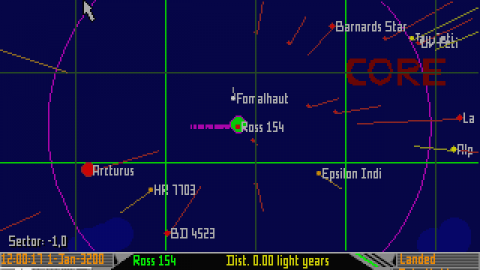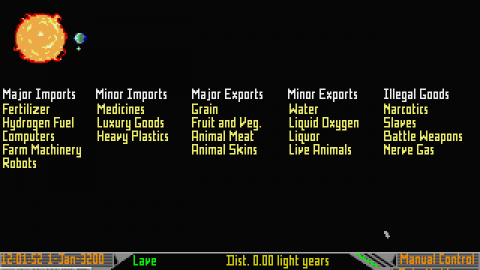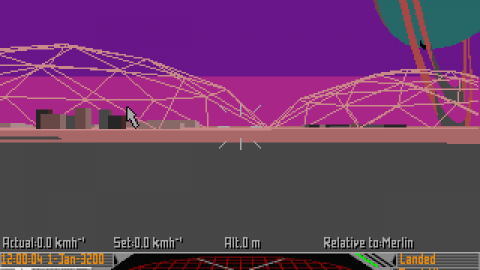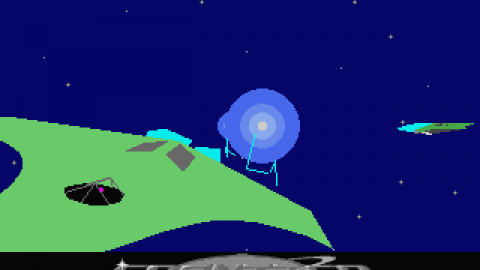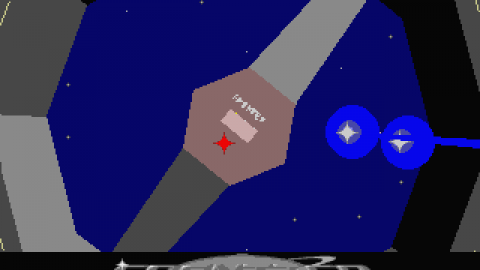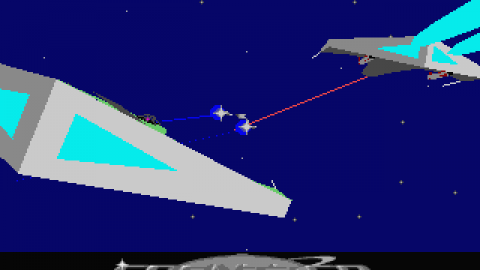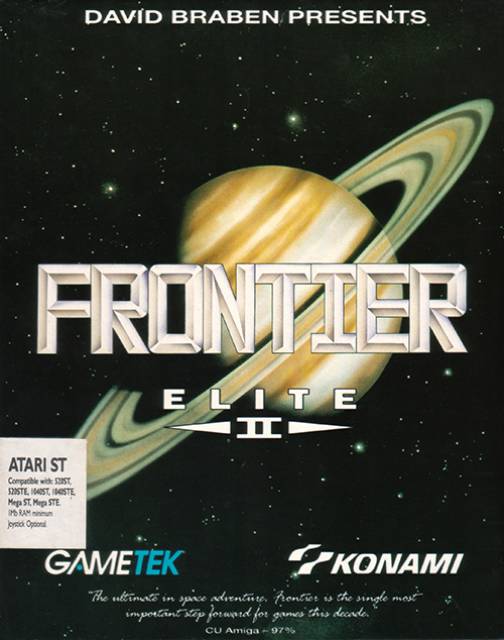Overview
Frontier: Elite II was the sequel to the seminal Elite and furthered the ambition of an open ended space trading game. The sequel brought with it markedly improved physics and a realistically modelled galaxy. To augment the open-ended nature of the game the universe was procedurally generated and real sized planets despite there being little to explore on them.
Plot
Whilst no plot emerges during gameplay there is a plot present in the manual which sets the premise of the game. Fresh from victory in the Thargoid War during the original game humanity finds itself in crisis. With the Thargoids retreated to their own territory humanity has fallen into a cold war between the militaristic Federation and the slave owners of the Imperial Fleet. After a short war a tense ceasefire is in effect made worse by new anarchic systems taking advantage of the fear of military action by operating without law. You enter the world as always with 100 credits and a ship as the original protagonists grandchild, with no alliances to the factions and a chance to carve your own path in the world.
Gameplay
Changes from Elite
Whilst Elite restricted you to one ship, Frontier: Elite II encouraged purchase of new ships to suit your style of play. Military vessels ranged from light fighter crafts to mammoth naval style crafts with trading crafts offering larger cargo space and mining crafts coming with specific mining lasers. Graphics are understandably improved with texture mapping and curved polygons moving the series from the simplistic wireframe style of the original.
Factions
The game has two primary factions which players may join. The Federation based on Earth and The Empire based in the Achenar system. Progress through both involved completing missions given at bases which allowed for promotions. The reality was that there was little gameplay difference between the two aside from the location of the base and how that would affect trade routes. The Empire was more permissive of slavery allowing for new trading opportunities whilst slavery was an arrestable offence in Federation territories. Certain ships were also designated as being independent, Federation or Empire ensuring they were out of bounds to those in an opposing faction. Finally upon joining a faction it locked off the enemies portion of space due to enemies becoming hostile upon spotting you.
Control
Unlike Elite, whose controls were arcade style, Frontier opted for a rigid Newtonian physics model making flight control and dogfights highly difficult. In moving momentum had to be considered as did gravitational pull. Whilst difficult this did offer emergent gameplay such as using planets to slingshot great distances (not programmed in but emergent through the physics model). This put control closer to a flight simulator than the arcades. Making gameplay approachable despite these difficulties was done in two ways. Firstly long distance travel is done by use of the hyperdrive which makes long distance travel extremely quick and day to day such as docking and navigating to positions for using the hyperdrive can be handed to the autopilot.
Earning Credits
The game starts you with one hundred credits and an Eagle Long Range Fighter, setting you loose on an open ended universe. As with Elite the game concerns engaging in legal or illegal trading to earn credits and advance in whatever fashion the player desires. The game revolves around finding the most profitable trading routes and running them to earn maximum credits. Trading can be done by simply purchasing from ports or by mining asteroids however the cost of a mining vessel does restrict that aspect of the game until later levels. Certain items are deemed illegal in various ports and planets (such as narcotics) with the reward of lucrative black market trading being offset by the risk of police intervention. Again though black market trading involves a certain amount of investment (life support for cargo bay to transport slaves for example) which limits it to a more advanced player. Beyond trading bounty hunting and military missions can both be highly profitable but come with inherent risks. Bounty hunting taking you into anarchic systems and to highly dangerous ships with military missions raising your rank by allying you to a faction and to a set of solar systems whilst making you unwelcome in others.
Bugs
Rushed for release in the UK for Christmas 1993 the game was filled with bugs. These ranged from inconsistencies between the booklet and the game (with regards to ship details) to incorrect prices paid for gems in the Cemiess system making trading there almost game-breakingly lucrative. The only bug which required a patch however was the "mining glitch" where attempting to leave equipment in a system ended in a crash. The most famous of bugs however is the wormhole bug which exploited a maths overflow in calculating hyperspace distances. In essence is the jump distance was exactly 655.36 light years the game would allow a jump regardless of ship capabilities. This was removed for the versions released after 1993 however it has made the freeware UK version the most popular. Moving away from bugs large portions of the game seemingly suffers from it's ambition by showing a lack of polish. Ships such as "The Lion" cannot handle having turrets installed as it simply fires into it's own wing and missiles being largely unable to damage crafts. Whilst minor there are instances of this lack of polish impacting strongly on gameplay as can be seen by the police AI being astonishingly poor resulting in police chases being impossible due to the police crafts crashing into each other almost instantly.
Ships
Interplanetary Shuttle
Lifter
Osprey
Falcon
Hawk Airfighter
Kestrel Airfighter
Eagle Mk. I
Eagle Mk. II
Eagle Mk. III
Sidewinder
Krait
Gecko
Adder
Viper
Cobra Mk. I
Moray Starboat
Cobra Mk. III
Constrictor
Asp Explorer
Transporter
Lion Transport
Tiger Trader
Imperial Courier
Imperial Trader
Python Freighter
Anaconda
Puma Shuttle
Boa
Panther Clipper
Easter Eggs
As with Elite there are countless Easter eggs present in Frontier: Elite II.
- The developers have claimed there is a black hole in the game which can be found at the center of the universe.
- Around the planet "industry" there is a space station called "Ridley Scott" as an tribute to the Alien franchise.
- As a thank you for porting Frontier to the PC adverts for Chris Sawyer's "Transport Game" can be found in space stations.
- The planet "Scott" has a space station called "Amundsen" after the North Pole explorers.
Sequels
The only sequel received was Frontier: First Encounters which launched for the PC in 1995 to mixed reviews due to its premature release drawing criticism of it being half finished. A proposed modern iteration named Elite 4 was planned and down as being under development on the Frontier Developments website but was never shown. On November 5th 2012 Frontier Development launched a Kickstarter to help fund development of Elite: Dangerous, a sequel in the genre and spirit of the original games for release in 2014. The project achieved it's goal and raised over £1.5 million in funding.

 Amiga
Amiga PC
PC